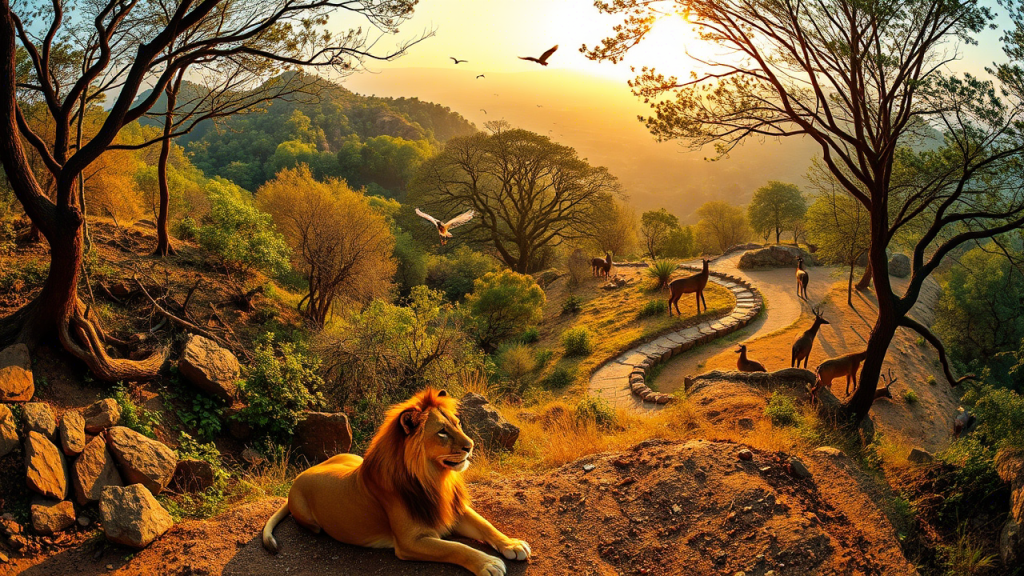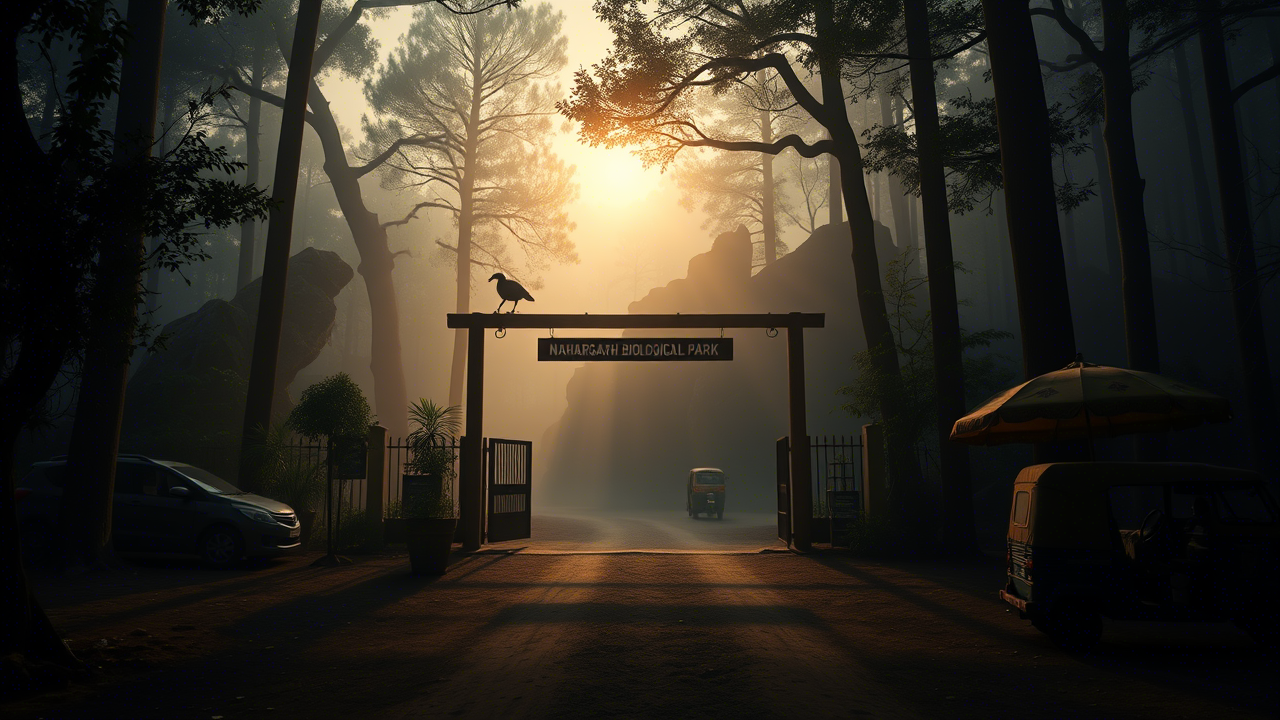- Private car and driver in Delhi / India
- +91-8447445445
- info@discoverindiabycar.com sugar.ankit@yahoo.com
 +91-9818434712
+91-9818434712
Nahargarh Biological Park: Jaipur’s Wild Heart – An Expert Guide

Nahargarh Biological Park: Tapping into Jaipur’s Wild Soul
Think Jaipur, and images of grand forts and vibrant markets probably spring to mind, right? Amber Fort’s grandeur, Hawa Mahal’s intricate facade, the buzz of Johari Bazaar – it’s a city steeped in history and culture. But tucked away in the ancient Aravalli hills, just a short hop from the city buzz, lies a different kind of jewel – the Nahargarh Biological Park.
It’s this wild heart of Jaipur I want to take you through, a place offering a lungful of fresh air and a genuine connection with Rajasthan’s incredible wildlife. If you’re itching for an experience that mixes raw nature with a bit of adventure and meaningful conservation, you’ve found it.
Having spent over 15 years exploring and writing about places like this, I can tell you Nahargarh Biological Park offers a perspective on the region you won’t find anywhere else. Consider this your personal guide – everything you need to plan your trip and truly appreciate what makes this park tick.
So, What’s the Story Behind Nahargarh Biological Park?
Alright, let’s get specific. You’ll find Nahargarh Biological Park along the Jaipur-Delhi highway, nestled close to the iconic Nahargarh Fort. This isn’t just another enclosure; it’s a key piece of the larger Nahargarh Sanctuary. We’re talking over 720 hectares carved out within the Aravallis, one of the planet’s oldest mountain ranges. The Rajasthan Forest Department set it up with some clear goals in mind, and it’s more than just putting animals on display.
- Saving Species: First and foremost, it’s about protecting and helping breed animals native to Rajasthan and India that are facing tough times – think endangered or threatened species.
- Spreading the Word: It’s also a classroom without walls. The park aims to get visitors thinking about wildlife, why biodiversity matters, and the nuts and bolts of conservation.
- A Natural Escape: And yes, it’s a place to simply be in nature. It provides a space for folks to see animals in environments that feel much closer to the wild, all managed ethically.
The location itself is special. Those rugged hills, the dry forests that change with the seasons, the rocky outcrops – they don’t just look good; they form a vital habitat. When you step into Nahargarh Biological Park, you’re entering a living, breathing ecosystem that’s crucial for the region.

Meeting the Residents: Who Lives Here?
The real magic of Nahargarh Biological Park, naturally, is the animals. Forget cramped cages; the park focuses on large, thoughtfully designed enclosures that give the residents room to roam and behave naturally.
The Big Cat Royalty: Lions, Tigers, and Leopards
- Asiatic Lions: Let’s be honest, these guys are a major draw. Nahargarh Biological Park gives you a chance to see these magnificent Asiatic Lions, whose wild cousins are now only found in Gujarat’s Gir Forest. Spotting them lounging or surveying their territory during the Lion Safari? Truly unforgettable.
- Bengal Tigers: India’s national animal, the powerful Bengal Tiger, also calls this park home. Those iconic stripes aren’t just for show; they’re perfect camouflage in the dappled sunlight filtering through the trees. Catching sight of a tiger here feels like a privilege, a reminder of the wildness the park helps protect.
- Indian Leopards: Now these cats are masters of stealth. The Aravalli terrain within Nahargarh Biological Park is their kind of place – rocky, with plenty of cover. Seeing a leopard often comes down to patience and maybe a bit of luck, making a sighting feel like a real reward.
Beyond the Big Cats: A Wider World of Mammals
It’s not all about the apex predators, though. Nahargarh Biological Park showcases a fantastic range of other mammals:
- Sloth Bears: With their unique shaggy look and long snouts, these bears are fascinating to watch, whether they’re shuffling around looking for food or taking a rest.
- Hyenas: You might hear the distinctive calls of the Striped Hyenas before you see them in their dedicated zone.
- Graceful Grazers: Keep your eyes peeled for herds of Sambar (India’s largest deer), the beautifully spotted Chital, and the sturdy Nilgai (Blue Bull). Seeing them move through their large habitats adds a real sense of scale to the park.
- And More: The list goes on! Wolves, jackals, desert foxes that blend perfectly with the landscape, wild boars, and even prickly porcupines are part of the diverse community at Nahargarh Biological Park.
Feathered Friends: A Treat for Birders
Don’t forget to look up! Nahargarh Biological Park is a surprisingly good spot for birdwatching. The mix of forest, scrubland, and rocky areas attracts a host of feathered residents and visitors:
- You’ll almost certainly see Peacocks, maybe even a male displaying his breathtaking train.
- Listen for the calls and scan the skies and trees for various owls, eagles, and vultures.
- Smaller flashes of colour could be parakeets, while babblers, drongos, and woodpeckers are common sights.
- If there are water sources, keep an eye out for water birds, especially during the cooler migration season.
A pair of binoculars will definitely enhance your birding experience here.
Scales and Snouts: The Reptilian Realm
The park also provides safe harbour for reptiles. Specially designed areas house crocodiles and the critically endangered Gharial, a fish-eating crocodilian with a distinctively long snout. While harder to spot, various native snakes and lizards also thrive within the park’s protective boundaries.

Making the Most of Your Visit: What to Do at Nahargarh Biological Park
Your adventure at Nahargarh Biological Park can unfold in a few different ways:
The Safari Experience: Getting Closer (Safely!)
- Lion Safari: This is often top of the list. You’ll board a secure vehicle that takes you inside a large, fenced zone where the lions live. It’s a fantastic way to observe them in a space that feels much more natural than a traditional zoo.
- Tiger Safari: Similar setup, different star! This safari takes you into the tiger’s territory, offering the chance for those pulse-pounding sightings.
Just a heads-up: Animal sightings are never guaranteed – it’s nature, after all! But the safaris definitely boost your chances. Always check safari timings and availability before you go.
Wandering the Zoological Park
Beyond the safaris, much of Nahargarh Biological Park invites exploration on foot. Follow the pathways winding through different zones, each housing various species in enclosures designed to mimic their natural homes. This lets you observe at your own pace, soak in the atmosphere, and maybe get that perfect photo (without the flash, usually!).
Finding the Birding Hotspots
While birds are everywhere, some spots – maybe near a water body or in a particularly dense patch of trees – can be extra rewarding. Early mornings are prime time for bird activity, when the air is cooler and the birds are most active.
Learning Along the Way
Keep an eye out for information boards scattered through the park. These often share cool facts about the animals, their conservation status, and why the Aravalli ecosystem, where Nahargarh Biological Park sits, is so important. It adds another layer to your visit, turning sightseeing into a learning experience.

Nitty-Gritty: Planning Your Trip to Nahargarh Biological Park
A bit of planning makes everything smoother. Here’s the lowdown:
Getting There: Location and Transport
You’ll find Nahargarh Biological Park on NH-8 (the Jaipur-Delhi Highway), roughly 12-15 km outside Jaipur city proper.
- Car/Taxi: Easiest option. Hire a cab for the day or drive yourself. Parking is usually available.
- Auto-rickshaw: Totally doable from Jaipur. Just make sure you agree on the fare upfront, including waiting time if needed.
- Public Transport: Local buses might get you close, but you might have a bit of a walk or need a final connection. Best to check current routes locally if you go this route.
Opening Hours & Costs
- Timings: Generally, the park opens around 8:30 AM in summer / 9:00 AM in winter and closes by 5:00 PM / 5:30 PM. Crucially, it’s usually closed one day a week (often Tuesday). Always, always double-check the official Rajasthan Forest Department website or call ahead for the latest times, closure days, and entry/safari fees. Things can change!
- Fees: Expect an entry fee for the park itself, plus separate tickets for the Lion and Tiger Safaris. Prices are reasonable but subject to change.
When’s the Best Time for a Visit?
- Season: Hands down, the cooler months from October to March are the most comfortable. The weather’s pleasant for walking, and animals are often more active during daylight hours.
- Time of Day: Try to get there early in the morning or go later in the afternoon. Animals, like us, tend to take it easy during the hottest part of the day, especially in summer. You’ll likely see more activity during these cooler periods at Nahargarh Biological Park.
What Facilities Can You Expect?
- Parking: Yes, usually near the main entrance.
- Washrooms: Basic facilities are available.
- Food & Drink: Don’t expect a full restaurant. There might be a small stall near the entrance selling basic snacks and water, but options are limited. Best bet? Bring your own reusable water bottle and maybe some light snacks.
- Getting Around: Paths are generally manageable, but the terrain can be uneven. If you have specific accessibility needs, it’s wise to inquire beforehand.

A Few Friendly Tips for Visiting Nahargarh Biological Park
- Dress smart (and comfy): Think neutral colours (greens, browns) to blend in a bit. Comfortable walking shoes are non-negotiable.
- Sun’s strong! Hats, sunglasses, sunscreen – pack ’em, especially if visiting outside the peak winter months.
- Water is your friend: Stay hydrated. Carry enough water for your visit.
- Quiet, please! Keep your voice down. Loud noises stress the animals and reduce your chances of seeing them behave naturally. Shhh!
- No feeding: Seriously, don’t feed the animals. It’s bad for their health and messes up their natural instincts. Strictly forbidden.
- Pack it in, pack it out: Use the bins provided or take your trash with you. Let’s keep Nahargarh Biological Park clean.
- Listen to the guides: Follow the rules and any instructions from park staff, especially on safari. They know best.
- Camera ready? Photography is usually fine, but check about flash (often discouraged) or if there are extra fees for bigger cameras. Drones are almost certainly a no-go.
- Patience pays off: Wildlife watching isn’t like flicking channels. Relax, enjoy the atmosphere, and appreciate whatever nature reveals. Respecting the space is key to a good experience for everyone.
More Than Just a Day Out: Conservation is Key at Nahargarh Biological Park
It’s easy to just enjoy the animals and the scenery, but remember, Nahargarh Biological Park is doing serious conservation work behind the scenes. This place plays a vital role in:
- Boosting Numbers: Providing a safe haven for breeding endangered species like those Asiatic lions is crucial for their long-term survival.
- Protecting Habitat: Managing this patch of the Aravallis helps conserve the unique plants and animals that call this ancient range home.
- Helping Hands: Sometimes, the park acts as a rescue centre for animals found injured or in distress, giving them a chance at recovery.
- Learning More: It’s a living laboratory. Researchers can study animal behaviour and health here, gathering data that informs wider conservation strategies across India.
So, when you visit Nahargarh Biological Park and follow the rules, you’re actually playing a small part in supporting these bigger conservation goals. Your entry fee helps keep these programs running.

Got Questions? Your Nahargarh Biological Park FAQs Answered
Q1: How much time should I set aside for Nahargarh Biological Park?
A: Good question! Aim for at least 3-4 hours. That gives you enough time to walk the main zoo areas and maybe do one safari comfortably. If you’re really into birding or want to squeeze in both the Lion and Tiger Safaris, give yourself a bit longer, maybe 4-5 hours.
Q2: Are the safaris at Nahargarh Biological Park genuinely safe?
A: Yes, absolutely. They use specially designed, enclosed vehicles, and trained staff are always present. Safety rules for both visitors and the animals at Nahargarh Biological Park are taken very seriously.
Q3: What are the ‘must-see’ animals at Nahargarh Biological Park?
A: The big draws are definitely the Asiatic Lions, Bengal Tigers, and Leopards. But don’t miss the Sloth Bears, Hyenas, the various deer (Sambar, Chital), crocodiles, and the birdlife! Just remember, sightings aren’t guaranteed – it depends on the day and the animals’ moods!
Q4: Can I take photos inside Nahargarh Biological Park?
A: Generally, yes, for your own personal memories. You might find there are extra fees if you have professional-looking camera gear. Using flash is often frowned upon or prohibited, as it can startle the animals. Always best to check the specific rules when you arrive.
Q5: Is it practical to visit both Nahargarh Biological Park and Nahargarh Fort on the same day?
A: Yes, lots of people do this as they are relatively close. You could visit the park in the afternoon and then head up to Nahargarh Fort for its famous sunset views over Jaipur (or vice-versa, depending on park timings). Just factor in travel time between the two spots.
Q6: What about food inside Nahargarh Biological Park? Are there cafes?
A: Facilities are quite basic. You might find a small kiosk near the entrance selling packaged snacks and bottled water, but don’t count on a proper meal. Bringing your own water and maybe some fruit or trail mix is a smart move.
Q7: Is Nahargarh Biological Park a good place to take kids?
A: Definitely! It’s a fantastic opportunity for kids to see animals they might only have read about and learn about nature. The safaris, in particular, are usually a big hit. Just keep them close, ensure they follow the ‘quiet’ rule, and stay safely back from enclosures.
Wrapping Up: Why Nahargarh Biological Park Deserves Your Time
Nahargarh Biological Park really offers something different from Jaipur’s main tourist trail. It’s less about ancient stones and more about living creatures, less about city clamour and more about the quiet rustle of leaves or the distant roar of a lion. It’s where you can breathe deep, connect with nature, and appreciate the wild diversity that Rajasthan holds, all thanks to dedicated conservation efforts.
From the genuine thrill of a safari sighting to the simple pleasure of watching deer graze peacefully, the park leaves a lasting impression. It serves as a vital reminder of the beautiful, fragile natural world that exists alongside our busy human lives. So, next time you’re in or near Jaipur, carve out a few hours. Step away from the forts and palaces for a bit, and go explore the wild side at Nahargarh Biological Park. Trust me, it’s an experience that stays with you long after you’ve left the Aravalli hills behind.











